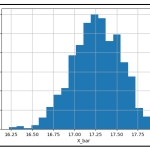One of many nice issues about Julia is the language’s extensibility. With Julia, the entire modules can make the most of the capabilities offered by the Base module so as to add new strategies. In different phrases, modules can mix seemlessly with the Base and infrequently be handled like Base sorts. Because of this if we find out how these strategies work with Base we’ll most likely be capable of carry plenty of that information with us into different modules. Right this moment we’ll exhibit this by beginning with Base after which increasing into filtering a distinct construction from a dependency, a DataFrame from DataFrames .
Filtering base sorts
There are just a few totally different methods that can be utilized to filter a easy Vector . One function that I feel is comparatively new to Julia is the flexibility to offer conditional masks as indexes. I’m not certain how lengthy this has been included with Base , however that is actually an superior function, as I like conditional masks. To create a conditional masks, we have to make one of many BitArrays we talked about earlier. On this occasion, we’ll broadcast a comparability operator once more. Right here we’ll filter any worth above 14 out of x:
x = [5, 10, 15, 20]
xmask = x .< 14
x[xmask]
2-element Vector{Int64}:
5
10
Alternatively, we may make the most of the filter strategies. These are filter and filter! . These two strategies do the identical precise factor, the one distinction is that filter! is a mutating technique. That is exactly what the ! in operate names is supposed to symbolize. I discover that to be a extremely cool customary because it does actually make it simpler to discern when issues are being mutated and when they don’t seem to be. I feel that could be a good thing to know, particularly with regards to Information Science. The filter technique is supplied with a Perform as the primary positional argument after which our Vector because the second positional argument. This would possibly change barely if the sort isn’t a Vector , so preserve that in thoughts.
filter(x::Int64 -> x < 14, x)2-element Vector{Int64}:
5
10
Provided that we used filter as a substitute of filter! right here, we would wish to set x equal to the return to implement these modifications. One other factor we are able to filter utilizing this method is dictionaries. Moderately than offering the kind of every factor within the Vector , we as a substitute work with a Pair .
mydict = Dict(:A => [5, 10], :B => [4, 10])filter(okay::Pair{Image, Vector{Int64}} -> okay[2][1] != 5, mydict)
Dict{Image, Vector{Int64}} with 1 entry:
:B => [4, 10]
As a result of the operate is the primary positional argument, this additionally opens up the flexibility to make the most of the do syntax, so undoubtedly preserve this in thoughts.
x = [5, 10, nothing, nothing, 40]filter!(x) do quantity
~(isnothing(quantity))
finish
3-element Vector{Union{Nothing, Int64}}:
5
10
40
Filtering dataframes
One other frequent kind of construction that may should be filtered is the DataFrame . This can be a bit totally different as a result of it’s a dependency and a module, not only a portion of Base .
utilizing DataFramesdf = DataFrame(:X => [1, 2, 3, 4], :Y => [1, 2, 3, 4])
The filter technique when used on a DataFrame will present a DataFrameRow to the operate. This can be a cool kind, we are able to index it fairly simply and this makes filtering a breeze.
filter!(df) do row
if row[:X] > 3
return(false)
finish
true
finish
That basically is all there may be to it, and with the preexisting information from Base , it could be arduous to search out issues that aren’t potential to filter with this method!


